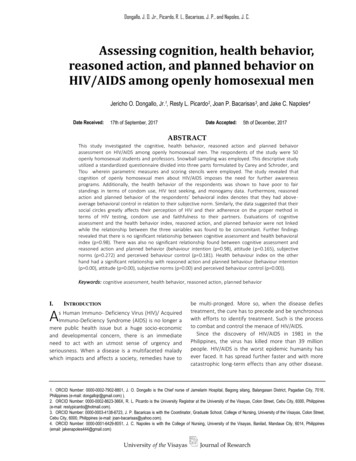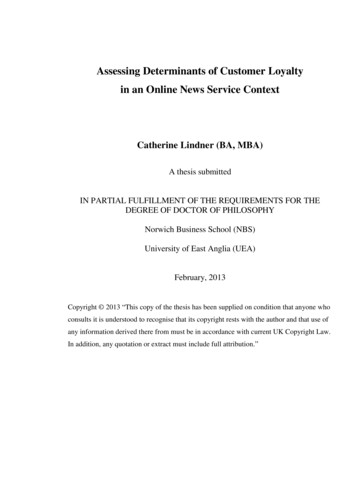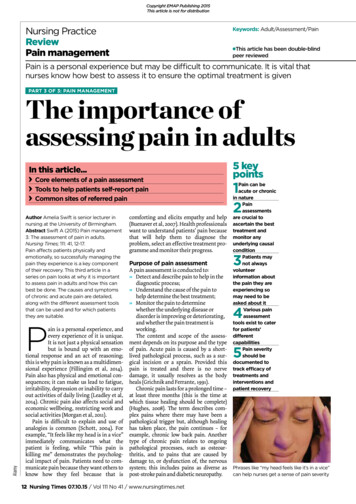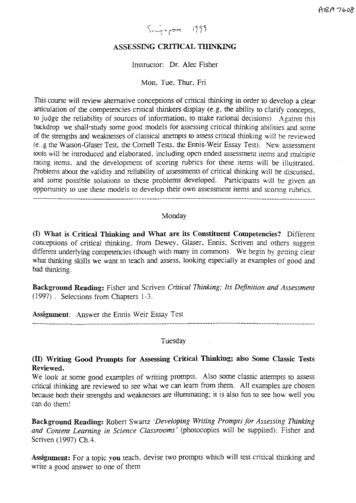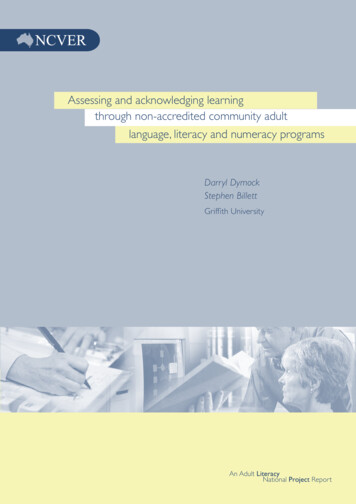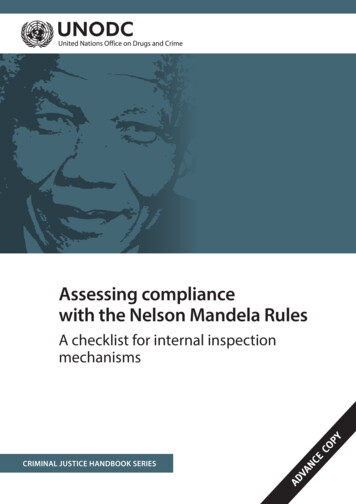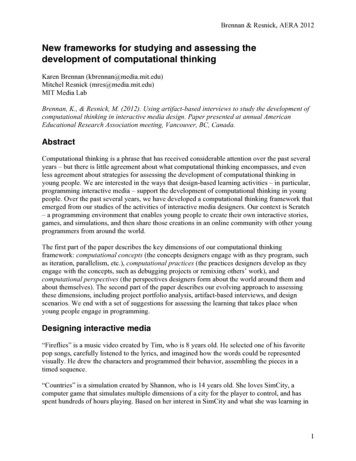
Transcription
INTERPERSONAL RELATIONS AND GROUPPROCESSESThe Relationship Closeness Inventory:Assessing the Closeness of Interpersonal RelationshipsEllen Berscheid and Mark SnyderUniversity of MinnesotaThis document is copyrighted by the American Psychological Association or one of its allied publishers.This article is intended solely for the personal use of the individual user and is not to be disseminated broadly.Allen M. OmotoUniversity of KansasThis article describes the development of the Relationship Closeness Inventory (RCI), which drawson the conceptualization of closeness as high interdependence between two people's activities proposed by Kelley et al. (1983). The current "closest" relationship of individuals (N 241) drawnfrom the college student population served as the basis for RCI development, with the closest relationship found to encompass several relationship types, including romantic, friend, and family relationships. The development and psychometric properties of the three RCI subscales (Frequency, Diversity, Strength), their scoring, and their combination to form an overall index of closeness are described. The RCI's test-retest reliability is reported and the association between RCI score andthe longevity of the relationship is discussed. RCI scores for individuals' closest relationships arecontrasted to those of not-close relationships, to a subjective closeness index, and to several measuresof relationship affect, including Rubin's (1973) Liking and Loving scales. Finally, the ability of theRCI to predict relationship break up is contrasted to that of the Subjective Closeness Index, an indexof the emotional tone of the relationship, and to relationship longevity. It is concluded that theRCI possesses acceptable internal and test-retest reliability, satisfactory discriminant and constructvalidity, and encouraging predictive validity, thus suggesting that it constitutes a viable means ofassessing relationship closeness.The study of interpersonal relationships has burgeoned in recent years across a variety of disciplines. Investigators increasingly have recognized the theoretical and practical importanceof studying close relationships. As Clark and Reis (1988) concluded in their recent review of the relationship literature, closeness is a process that appears to underlie many relationship phenomena that have long been of interest. Thus, the need for botha theoretical conceptualization of closeness and a means of assessing closeness in ongoing relationships has become clear.The closeness of interpersonal relationships has been definedand measured in a variety of ways (see Berscheid, Snyder, &Omoto, 1989, for a discussion of this point). Few definitionsand fewer measures, however, have been derived from carefulconceptualizations of closeness, and the reliability and validityof many currently used closeness measures remain to be examined. We present here an instrument for assessing relationshipcloseness for which the conceptualization of closeness outlinedby Kelley et al. (1983) served as the heuristic.Kelley et al. (1983) emphasize the interdependence that existsbetween relationship partners as evidenced in their day-to-dayactivities, and thus stress assessment of th& properties of the interaction between two people. Specifically, they propose that aclose relationship is characterized by high interdependence,whereWe acknowledge two grants-in-aid of research from the GraduateSchool of the University of Minnesota.We would also like to thank Brian Kojetin and Mark Attridge, of theUniversity of Minnesota, for their invaluable help in collecting some ofthe data and performing some of the statistical analyses, as well asGeorge Levinger, of the University of Massachusetts—Amherst, for hisinsights on the association between the Relationship Closeness Inventory and longevity.Correspondence concerning this article should be addressed to EllenBerscheid or Mark Snyder, Department of Psychology, University ofMinnesota, 75 Bast River Road, Minneapolis, Minnesota 55455; or toAllen M. Omoto, Department of Psychology, Fraser Hall, University ofKansas, Lawrence, Kansas 66045.A high degree of interdependence between two people is revealed infour properties of their interconnected activities: (1) the individualshave frequent impact on each other; (2) the degree of impact pereach occurrence is strong; (3) the impact involves diverse kinds ofactivities for each person; and (4) all of these properties characterize the interconnected activity series for a relatively long durationof time. (Kelley et al., 1983, p. 13)This conceptualization of closeness thus constitutes a roughblueprint for measuring the closeness of interpersonal relationships.The ideal way to assess relationship interdependence, as Kelley et al. (1983) discuss, would be for an omniscient investigatorJournal of Personality and Social Psychology, 1989, Vol. 57, Na 5,192-807Copyright 1989 by the American Psychological Association, Inc. 0022-3514/S9/S00.75792
This document is copyrighted by the American Psychological Association or one of its allied publishers.This article is intended solely for the personal use of the individual user and is not to be disseminated broadly.RELATIONSHIP CLOSENESS INVENTORYto observe the activities of both relationship partners continuously over a very long period of time, recording not only theiroutward behaviors but also their inner thoughts and physiological responses. The revealed interconnections between their activities would then be aggregated so as to arrive at assessmentsof the interaction properties of frequency, diversity, strength,and duration. Such observation is not possible, of course, andso one is immediately resigned to the fact that any attempt tomeasure interdependence between relationship partners as conceptualized by Kelley et al. is destined to reflect only the shadowof that interdependence. To the extent that this conceptualization of relationship closeness has power, however, even a roughindex of the partners' true interdependence should prove useful.On faith in that assumption, we attempted to devise an instrument for assessing relationship closeness with the followingcharacteristics:1. It should focus on the 1 st three properties of interactionhighlighted by Kelley et al. (1983): frequency, diversity, andstrength. (The property of duration poses special problems,which are discussed shortly.) In the absence of an omniscientobserver to record the actual interaction chain of events, howone assesses these properties is necessarily somewhat arbitrary.Nevertheless, we believed that however the assessment was to bemade, it should at least attempt to reflect the individual flavorof each of these properties of interdependence separately. Weassumed that although each of these properties may be an indicator of closeness, they need not be, and probably are not,strongly correlated across all of a person's relationships oracross all relationship types. Thus, the closeness measureshould be composed of several separate subindexes of closeness,each a reflection of one of the three properties specified.2. These individual indicators of closeness should be assessedin a way that permits an overall, or summary, index of closenessto be made for each relationship examined.3. The manner of assessing these indicators of closenessshould not be strongly tied to any one relationship type (e.g.,romantic relationships or friendships) and should not be predicated on any one population of persons (e.g., adolescents oryoung adults). In other words, the instrument should be as versatile as possible across all types of close relationships and subject populations.4. The instrument should be easy to administer and requirelittle of the respondent's time (15 min, at most), to allow itsinclusion in projects involving other measures addressed to awide variety of relationship questions.This last consideration virtually dictated a self-report instrument, with all the pitfalls and deficiencies inherent in such measures. A subsidiary aim, then, was to carefully structure thequestions posed to the respondent to minimize the influencesof social desirability, faulty memory, and wishful thinking, orto assess each dimension of closeness as much as possible as arelationship "outsider" might (Olson, 1977). Thus, we hoped toquery partners about specific relationship events that either hador had not occurred, events that could have been easily observed by others had they been present. Moreover, we attemptedto avoid asking the respondent to make global judgments andsummary statements about the relationship (see Ritter & Langlois, 1988) and to avoid, too, problems of language usage and793definition (e.g., what an investigator or respondent may personally mean by closeness, strength, and the like).MethodThe development of the Relationship Closeness Inventory (RCI) required a number of preliminary decisions, most importantly the selection of the type of relationship that would be used in its initial construction and the selection of a subject population.Selection of the "Closest" Relationshipfor RCI DevelopmentTo develop the RCI, we began by collecting theoretically relevant information about people's closest relationships. By asking people to report on the one relationship they believed to be the closest of all theirinterpersonal relationships, rather than simply on any one relationshipthey believed to be close, we borrowed a research strategy from the domain of personality and social behavior (see Snyder & Ickes, 1985). Thisstrategy suggests that a researcher interested in the dynamics of a socialpsychological phenomenon or process should identify and then studyindividuals who are particularly likely to manifest that phenomenon orprocess, thereby most efficiently and effectively gaining insight into thephenomenon or process as it naturally occurs. In like fashion, we reasoned that to study relationship "closeness," we should select individuals' closest relationships for initial examination to ensure that closenesswould indeed be present in the relationships examined, and that, if anything, there would be more of it rather than less of it to study. Thisdecision, however, also posed a risk: namely, that by selecting individuals' closest relationships, we would find little or no variability in relationship closeness, and hence be left with a relative inability to predictoutcomes of interest. This, however, was a risk we considered worthtaking in the initial development of a device intended to measure closeness.Selection of College Students as the Primary Populationfor RCI DevelopmentThe ubiquitous college student was chosen as the subject on whichinitial development of the RCI would be based, not only because collegestudents were in relatively abundant supply (a necessary condition forthe repeated administrations of the various forms and evolutions of theRCI), but because much of the close-relationship literature, as well asavailable data on other instruments to which we wished to compare theRCI, focuses on this subject population. Additionally, and from a lifespan developmental perspective, persons at this time of life, perhapsmore than any other, are actively engaged in developing close relationships.Thus, the primary sample from which the basic data on the RCI arereported consisted of 241 (116 male and 125 female) college students atthe University of Minnesota. Respondents ranged in age from 18-49years, with a mean age of 19.38 years. The modal participant was a 19to 20-year-old sophomore who was single and a full-time student. Allsecondary samples from which supplementary data are reported (andwhich are identified as secondary in the report to follow) were drawnfrom the same subject population and did not differ significantly withrespect to these characteristics of the primary sample.Identifying the Closest RelationshipIn the context of a mass-testing setting and in return for extra coursecredit, introductory psychology students who constituted the primarysample identified the one person with whom they had "the closest, deepest, most involved, and most intimate relationship," and then com-
E. BERSCHE1D, M. SNYDER, AND A. OMOTOThis document is copyrighted by the American Psychological Association or one of its allied publishers.This article is intended solely for the personal use of the individual user and is not to be disseminated broadly.794plctcd an extensive questionnaire about that relationship. After identifying their closest relationship by writing the first initial of their partner's name, respondents indicated the type of relationship they had withthat person by choosing 1 of 15 specific relationship descriptors (e.g.,brother or sister, dating only this person, etc.) that best characterizedtheir relationship with the nominated partner. From these descriptorsfour summary categories of relationship types were created: romantic,friend, family, and other relationships, this last category including workrelationships.We found that, by and large, our college students shared their closestinterpersonal relationships with romantic partners and friends. Specifically, 47% of our respondents nominated a romantic relationship astheir closest relationship, with friendships the second most frequentlynominated type (36%). The third major category of closest relationshipnomination was family relationships, although this type was nominatedrelatively infrequently (14%). Only a very small percentage of respondents (3%) nominated some other type of relationship (usually work) astheir closest relationship. There were no differences between men andwomen in the types of closest relationships nominated.This distribution of the closest relationship over several relationshiptypes was greeted with some relief for it revealed that, at least withinthis subject population, the closest relationship, on which we were tobase the development of our closeness measure, would not be hopelesslyconfounded wit
The development of the Relationship Closeness Inventory (RCI) re-quired a number of preliminary decisions, most importantly the selec-tion of the type of relationship that would be used in its initial construc-tion and the selection of a subject population. Selection of



